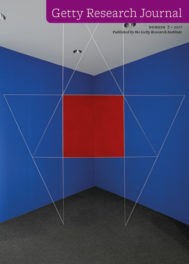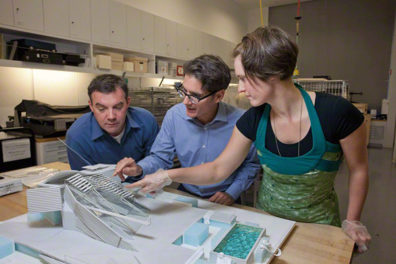
Photo from March 10, 2017, shows severe damage to the Umayyad (Great Mosque) of Aleppo—part of a UNESCO World Heritage Site—caused by fighting during the Syrian Civil War. Photo: Alfred Yaghobzadeh / Sipa USA (Sipa via AP Images) / © 2017 The Associated Press
On February 26, 2001, the Taliban leader Mullah Muhammad Omar called for the destruction of all statues and non-Islamic shrines in Afghanistan. “These statues have been and remain shrines of unbelievers,” he said, “and these unbelievers continue to worship and respect them. God Almighty is the only real shrine and fake idols should be destroyed.”
A few days later, the sixth-century monumental statues, carved into a cliff in the Bamiyan Valley of central Afghanistan and testifying to the majesty of Buddhist art and its transmission from India into central and Eastern Asia, were hit by anti-aircraft and tank fire and then blown up with dynamite.
The oasis town of Palmyra in Syria was even more dramatically damaged. Its most important shrine, a first-century temple dedicated to the Mesopotamian god Bel, was reduced to rubble. A second temple, dedicated to the other Palmyrene deity, Baalshamin, was then blown up. The triumphal arch on the colonnaded main street, which may have commemorated a Roman victory over the Parthians, was destroyed. Several of the city’s tower tombs were also demolished. And finally, the local archaeological museum was sacked, although much of its collection had been removed to Damascus for safekeeping.
Monuments of cultural heritage should be protected for what they are: sources of local communal identity and civil society, economic recovery, and, through the military concept of courageous restraint, regional security.
For too long, the international community has been slow to respond to this challenge. But things have finally begun to change.
In 1998 the Treaty of Rome established the International Criminal Court (ICC) and stipulated as crimes against humanity “intentional attacks against buildings dedicated to religion, education, art, science, or charitable purposes, historic monuments…provided they are not military objectives.” In September 2016 it secured its first conviction, when Ahmad Al Faqi Al-Mahdi confessed to attacking historic and religious buildings in Timbuktu.
A year later, the UN Security Council passed Resolution 2347 condemning the unlawful destruction of cultural heritage. It named as war crimes unlawful attacks against sites and buildings dedicated to religion, education, science, and historic monuments and strengthened the mandate of United Nations Peacekeeping operations to include the protection of cultural heritage from destruction in the context of armed conflicts.

The first in a new series, the J. Paul Getty Trust Occasional Papers in Cultural Heritage Policy, is available now: Cultural Cleansing and Mass Atrocities: Protecting Cultural Heritage in Armed Conflict Zones from Getty Publications (PDF, 50pp., 439KB)
Then just last October, a meeting was held at UN Headquarters to declare the link between the destruction of cultural heritage and terrorism and mass atrocities. Every speaker, including myself representing the Getty, argued for the protection of cultural heritage as both a local and a shared resource. UNESCO General-Director Irina Bokova went further and declared attacks on cultural heritage acts of “cultural cleansing”: vicious attacks on the identity of a people for the purpose of destroying them, their heritage, their livelihoods, and the prospects for post-conflict reconciliation and peacebuilding.
In December 2016, with the American Academy of Arts and Sciences, the J. Paul Getty Trust convened a meeting at the British Academy, London, to discuss an international framework for the protection of cultural heritage in zones of armed conflict.
All of these developments inspired the launch of a new initiative: The J. Paul Getty Trust Occasional Papers in Cultural Heritage Policy. The first paper, “Cultural Cleansing and Mass Atrocities,” addresses the threats to cultural heritage in armed conflict zones and the connection between the destruction of cultural heritage, cultural cleansing, and mass atrocities. It was written by Thomas G. Weiss, Presidential Professor of Political Science at the CUNY Graduate Center, and Nina Connelly, research associate at the Ralph Bunche Institute of the CUNY Graduate Center.
We hope the paper inspires continued dialogue and progress on this crucial issue. The paper is available for free download here.




Thank you for your continued commitment to preserving the world’s cultural heritage. It’s up to institutions like the Getty who can step up, to step up and be a force for good.
Often these monuments are of a sacred nature! The Bamiyan Buddhas are a prime example. I remember when I read about their destruction, but did not understand their pulverization until I saw the photos!! I was aghast! I had studied them in art history, but only knew of how they had been attacked in centuries past where only parts and pieces were broken off. To see the absolute erasure of them from human history is inexcusable and destroys not only heritage, but spirituality. As an artist and Buddhist/Christian theologian, this annihilation is sad and destroys and debilitates human interconnectedness at all levels. I think at this juncture, social justice now takes on a new meaning–justice for visual heritage –that plays such a vital role in culture, religion and society at large. Surely the recent meetings in Davos should play a role here as well.
We can not protect the people’s life in conflicts areas. before the art or heritage sites. In religious conflicts or ethnic conflicts or in terrorist activities you can’t protect nothing.
Please share your thoughts on the protection of America’s own cultural heritage art works, especially in the South. Many of our Civil War historic monuments have already been removed, demolished or defaced and those remaining continue to be openly threatened. Thank you.